- PRESS RELEASE
ECB publishes supervisory banking statistics for the fourth quarter of 2022
12 April 2023
- Aggregate Common Equity Tier 1 ratio up to 15.27% in fourth quarter of 2022 (compared with 14.74% in previous quarter and 15.60% in fourth quarter of 2021)
- Aggregated annualised return on equity up to 7.68% in fourth quarter of 2022 (compared with 7.55% in previous quarter and 6.70% one year ago), driven by increase in net interest income
- Aggregate liquidity coverage ratio stable in fourth quarter of 2022 at 161.46% and net stable funding ratio slightly down to 125.76%
Capital adequacy
The aggregate capital ratios of significant institutions (i.e. those banks that are supervised directly by the ECB) increased in the fourth quarter of 2022, consistent with seasonal patterns (year-end balance sheet compression) observed in the fourth quarters of previous years. The aggregate Common Equity Tier 1 (CET1) ratio stood at 15.27%, the aggregate Tier 1 ratio stood at 16.60% and the aggregate total capital ratio stood at 19.26%. Aggregate CET1 ratios at country level ranged from 12.60% in Spain to 22.86% in Estonia. Across Single Supervisory Mechanism business model categories, global systemically important banks (G-SIBs) reported the lowest aggregate CET1 ratio (14.21%) and development/promotional lenders reported the highest (30.27%).
Chart 1
Capital ratios and their components by reference period
(EUR billions; percentages)
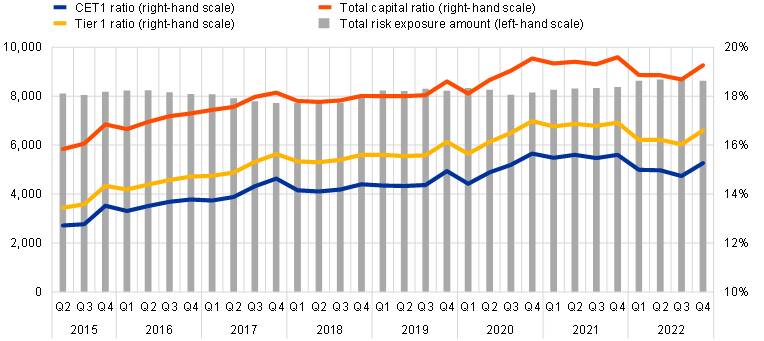
Source: ECB.
Chart 2
Capital ratios by home country for the fourth quarter of 2022
(percentages)
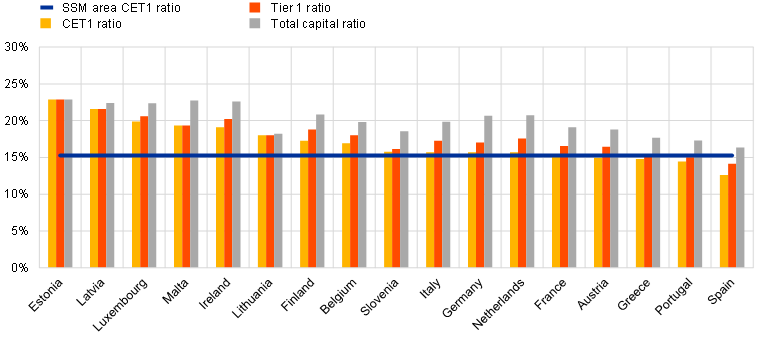
Source: ECB.
Note: Some countries participating in European banking supervision are not included in this chart, either for confidentiality reasons or because there are no significant institutions at the highest level of consolidation in that country.
Chart 3
Capital ratios by business model for the fourth quarter of 2022
(percentages)
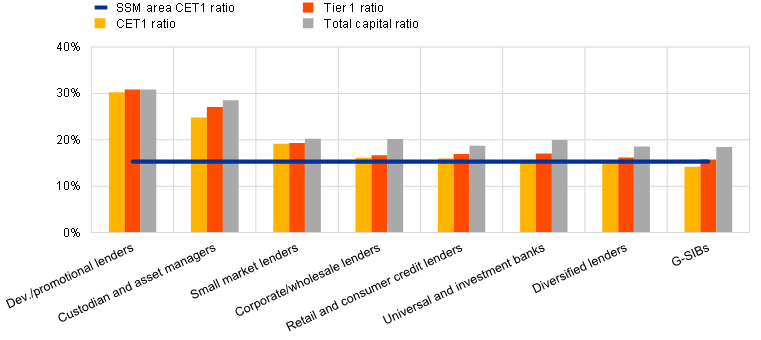
Source: ECB.
Notes: “G-SIBs” stands for global systemically important banks. “Dev./promotional lenders” stands for development/promotional lenders. Between the third and the fourth quarter of 2022 the following changes in business model classifications took place: two banks were reclassified from corporate/wholesale lender to diversified lender, two banks were reclassified from retail lender to diversified lender, and one bank was reclassified from not classified to corporate/wholesale lender.
Asset quality
The non-performing loans (NPL) ratio excluding cash balances at central banks and other demand deposits remained stable at 2.28% in the fourth quarter of 2022. Both the stock of NPLs (numerator) and loans and advances excluding cash balances (denominator) decreased, to €339 billion and €14,873 billion respectively.
Aggregate stage 2 loans as a share of total loans decreased to 9.63% (down from 9.82% in the previous quarter), reversing part of the increase observed during 2022. The stock of stage 2 loans amounted to €1,381 billion (compared with €1,434 billion in the previous quarter).
Forborne exposures decreased throughout 2022, reaching €331 billion in the fourth quarter (compared with €355 billion in the previous quarter and €402 billion one year ago), while their coverage ratios remained stable (5.16% for performing forborne exposures and 38.74% for non-performing forborne exposures).
Cost of risk was stable at an aggregate level of 0.47% in the fourth quarter of 2022 (compared with 0.48% in the previous quarter). Across significant institutions, the interquartile range narrowed further to 0.49 percentage points (down from 0.53 percentage points in the previous quarter).
Chart 4
Non-performing loans by reference period
(EUR billions; percentages)
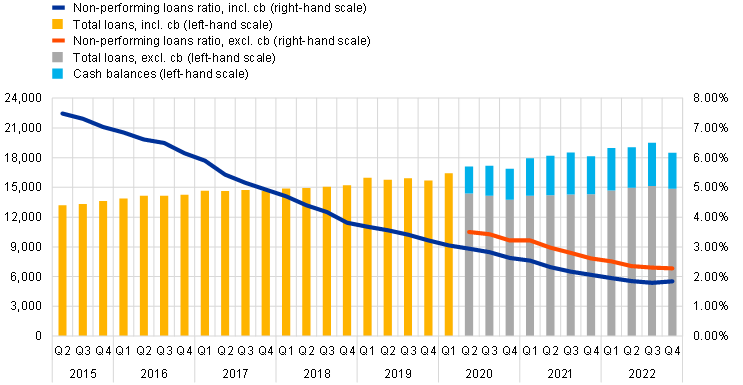
Source: ECB.
Note: “cb” stands for cash balances at central banks and other demand deposits.
Chart 5
Loans and advances subject to impairment review by reference period
(EUR billions; percentages)
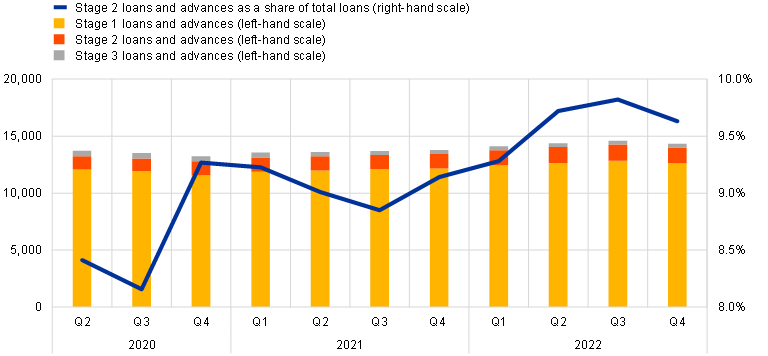
Source: ECB.
Note: Stage 1 includes assets where credit risk has not increased significantly since initial recognition, Stage 2 includes assets that have had a significant increase in credit risk since initial recognition, and Stage 3 includes assets that have objective evidence of impairment at the reporting date.
Chart 6
Loans and advances subject to forbearance measures by reference period
(EUR billions; percentages)
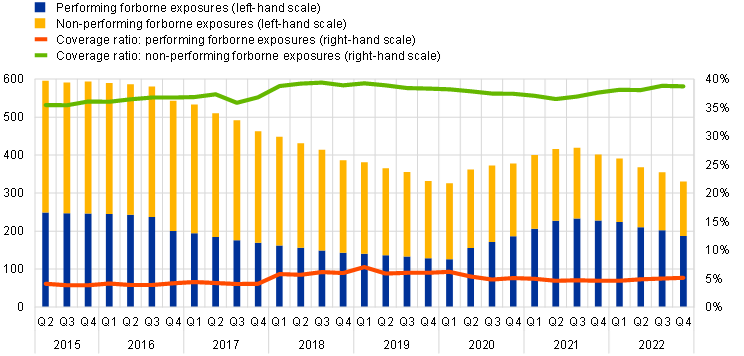
Source: ECB.
Chart 7
Cost of risk by reference period
(percentages)
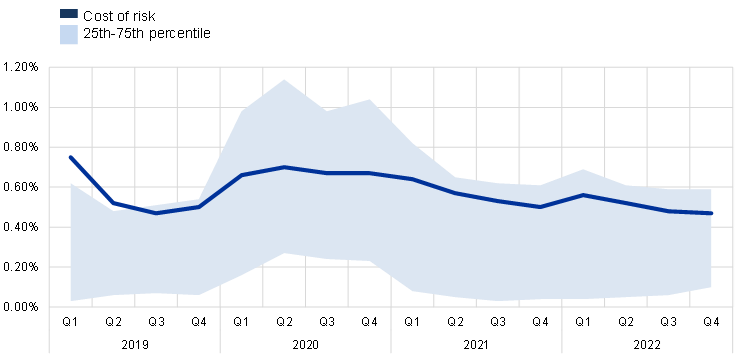
Source: ECB.
Return on equity
The aggregated annualised return on equity increased to 7.68% in the fourth quarter of 2022 (compared with 7.55% in the previous quarter and 6.70% one year ago). Higher net interest income was a key profitability driver compared with both the previous quarter (increase of €10.3 billion) and with the fourth quarter of 2021 (increase of €37.3 billion). In the fourth quarter of 2022 the net interest margin improved significantly to 1.36% (compared with 1.23% in the previous quarter and 1.21% one year ago).
Across Single Supervisory Mechanism business model categories, the aggregate annualised return on equity ranged from 13.27% for small market lenders to 3.23% for retail and consumer credit lenders.
Chart 8
Return on equity and composition of net profit and loss by reference period
(EUR billions; percentages)
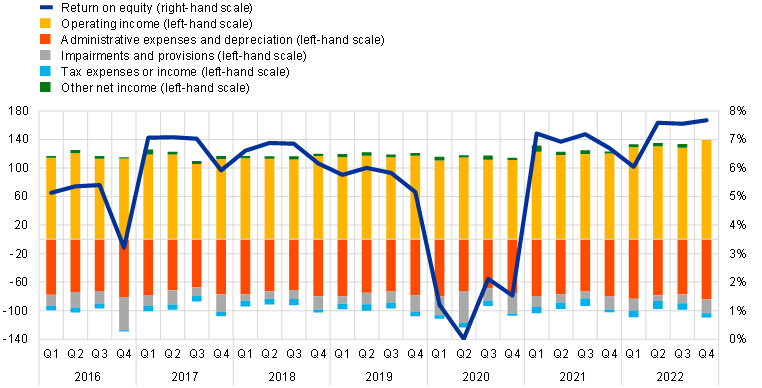
Source: ECB.
Chart 9
Return on equity by business model for the fourth quarter of 2022
(percentages)
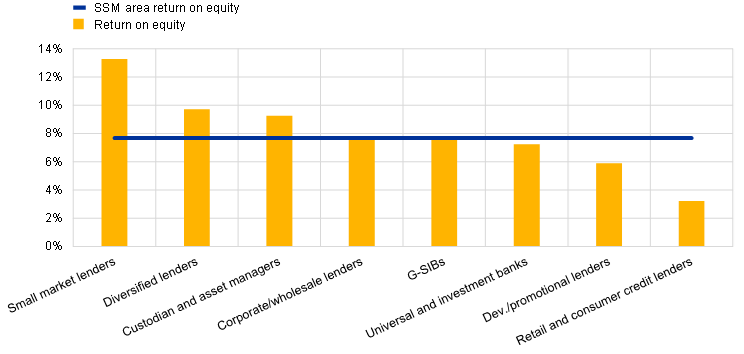
Source: ECB.
Note: “G-SIBs” stands for global systemically important banks. “Dev./promotional lenders” stands for Development/promotional lenders. Between the third and the fourth quarter of 2022 the following changes in business model classifications took place: two banks were reclassified from corporate/wholesale lender to diversified lender, two banks were reclassified from retail lender to diversified lender, and one bank was reclassified from not classified to corporate/wholesale lender.
Liquidity and funding
The liquidity coverage ratio stood stable at 161.46% in the fourth quarter of 2022 (compared with 161.99% in the previous quarter and 173.43% in the fourth quarter of 2021) while the net stable funding ratio decreased slightly to 125.76% (compared with 127.06% in the previous quarter and 129.40% in the fourth quarter of 2021).
Chart 10
Liquidity coverage ratio and its components by reference period
(EUR billions; percentages)
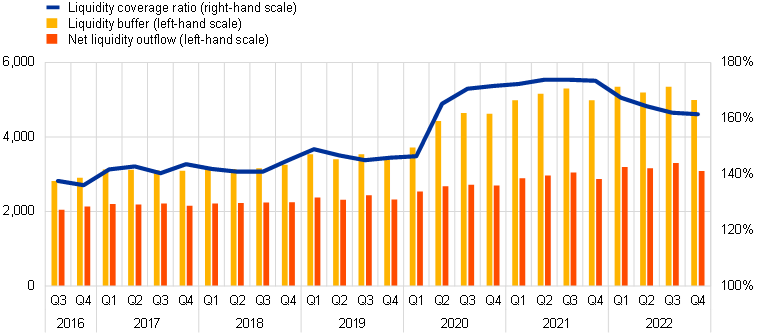
Source: ECB.
Chart 11
Net stable funding ratio and its components by reference period
(EUR billions; percentages)
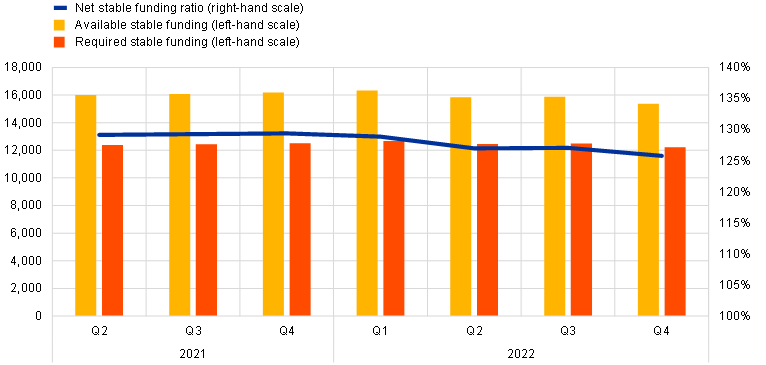
Source: ECB.
Loans and advances subject to COVID-19-related measures
In the fourth quarter of 2022 total non-expired loans and advances subject to COVID-19-related measures decreased further to €359 billion, down from €388 billion in the previous quarter. Statistics on COVID-19-related measures will no longer feature in our supervisory banking statistics as of the next quarterly release, as the European Banking Authority has repealed its Guidelines on COVID-19 reporting and disclosure.
Chart 12
Loans and advances subject to COVID-19-related measures by reference period
(EUR billions)
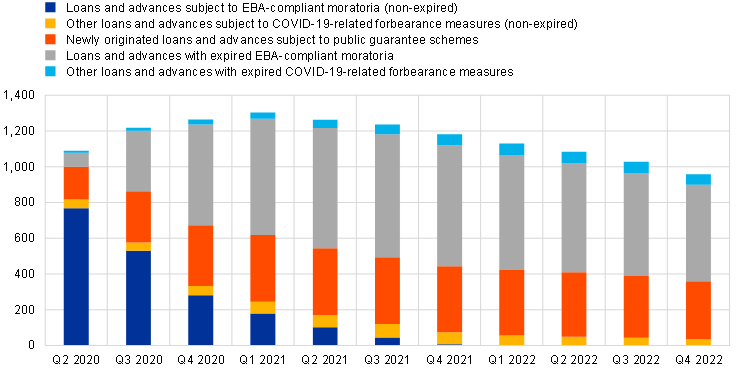
Source: ECB.
Note: “EBA” stands for European Banking Authority.
Factors affecting changes
Supervisory banking statistics are calculated by aggregating the data that are reported by banks which report COREP (capital adequacy information) and FINREP (financial information) at the relevant point in time. Consequently, changes from one quarter to the next can be influenced by the following factors:
- changes in the sample of reporting institutions;
- mergers and acquisitions;
- reclassifications (e.g. portfolio shifts as a result of certain assets being reclassified from one accounting portfolio to another).
For media queries, please contact Philippe Rispal, tel.: +49 69 1344 5482.
Notes
- The complete set of Supervisory banking statistics with additional quantitative risk indicators is available on the ECB’s banking supervision website.
Banque centrale européenne
Direction générale Communication
- Sonnemannstrasse 20
- 60314 Frankfurt am Main, Allemagne
- +49 69 1344 7455
- media@ecb.europa.eu
Reproduction autorisée en citant la source
Contacts médias

